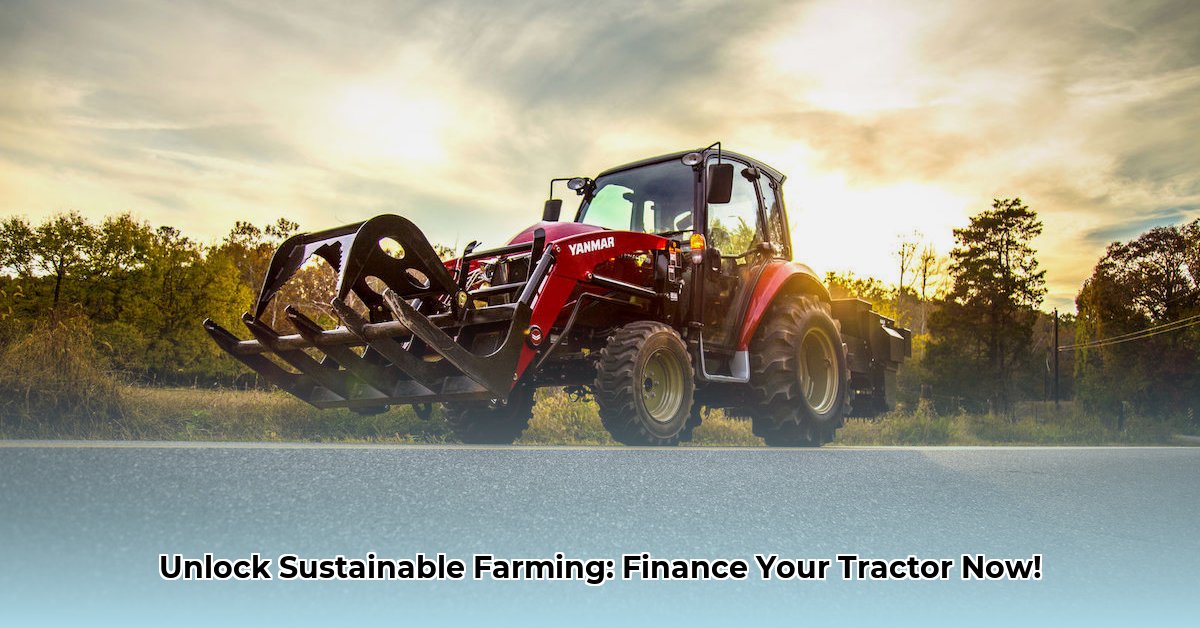
Securing funding for a new tractor, especially one geared towards sustainable farming practices, can feel daunting. This guide provides a step-by-step approach to navigating the financing process, empowering you to make informed decisions and secure the resources you need. Are you ready to invest in your farm's future? For more information on used tractor financing, check out this helpful resource: Used Tractor Loans.
Understanding Your Farm's Finances: Building a Solid Foundation
Before approaching lenders, understand your farm's financial health. Lenders assess your credit score (a numerical representation of your creditworthiness), debt-to-income ratio (a measure of your debt relative to your income), and financial history. A strong credit history, demonstrating consistent on-time payments and responsible debt management, significantly increases your chances of securing favorable loan terms. What steps can you take today to improve your credit score and strengthen your financial standing?
Pinpointing Your Funding Needs: Sustainable Farming Investments
Sustainable agriculture presents both challenges and opportunities. Precision agriculture technologies, renewable energy systems, and organic farming methods all offer long-term benefits, but they require upfront investment. Let's explore the costs involved:
Precision Agriculture: GPS-guided equipment, sensors, and software increase efficiency and reduce waste, but initial investment can be substantial depending on the chosen technologies.
Renewable Energy: Renewable energy sources like solar panels or wind turbines reduce energy costs and environmental footprint, but require significant capital investment initially.
Organic Farming: While organic produce commands higher prices, transitioning to organic farming necessitates investments in certifications, soil testing, and potentially altering land management practices.
To create a comprehensive budget, list all expected costs related to the tractor purchase and any associated sustainable farming upgrades. Include potential cost savings and revenue increases from adopting sustainable practices. Remember to factor in potential repair and maintenance costs. How will you ensure you have a solid financial plan in place?
Exploring Financing Avenues: Beyond the Usual Suspects
John Deere Financial and Kubota Finance are established options, but diverse financing avenues exist.
Traditional Farm Loans: These loans often offer lower interest rates, due to established lender relationships, but require strong credit scores and stringent requirements.
Government Grants and Subsidies: Many governmental agencies, including the USDA (United States Department of Agriculture), offer financial assistance for sustainable agricultural practices. These programs often come with specific eligibility criteria and competitive application processes.
Private Lenders: Banks and credit unions may offer specialized agricultural loan programs with potentially more flexible terms and a focus on sustainable practices.
Leasing: Leasing reduces upfront costs but results in higher overall costs over time as you don't own the equipment at the end of the lease.
Crowdfunding: Crowdfunding platforms can tap into a wider investor pool, but success is not guaranteed and requires a strong campaign emphasizing both environmental and economic benefits.
How will you strategically research and compare these diverse options to choose your best fit? A well-informed strategy is crucial.
Crafting Your Loan Application: A Step-by-Step Guide
A winning loan application clearly demonstrates responsible investment.
Gather Financial Documents: Compile your balance sheet, income statement, and cash flow statement for the past several years. These demonstrate your farm's financial health.
Develop a Business Plan: Outline your farm operations, market understanding, and revenue/expense projections. Detail how the tractor and sustainable upgrades will specifically contribute to your success. What are the key metrics you will use to assess progress?
Highlight Environmental Benefits: Quantify the environmental impact of your investment (e.g., "Reduce emissions by 15%," "conserve 20,000 gallons of water annually"). Lenders are increasingly prioritizing environmentally responsible projects.
Demonstrate Financial Viability: Project your return on investment (ROI). Show how this investment will generate increased revenue, reduce costs, or enhance efficiency. How will this investment improve your farm's bottom line?
Present a Polished Application: Ensure accuracy and professionalism, making the application organized, error-free, and easy to understand.
Negotiating Loan Terms: Securing the Best Deal
Don't accept the first loan offer. Carefully compare interest rates, repayment schedules, and prepayment penalties across multiple offers. Negotiate to obtain the most favorable terms. What specific negotiation strategies will you leverage to get the best possible deal?
Managing Your Loan: Responsible Stewardship
Create a dedicated budget for your loan, track expenses meticulously, and make on-time payments. This responsible management not only mitigates financial risks but also strengthens your creditworthiness for future ventures. How will you hold yourself accountable to a strict financial management system for your loan payments?
This comprehensive guide provides the tools to successfully finance your tractor and embark on a journey of sustainable farming. Remember, thorough planning and diligent research are key to securing funding and building a thriving, environmentally responsible farm.